



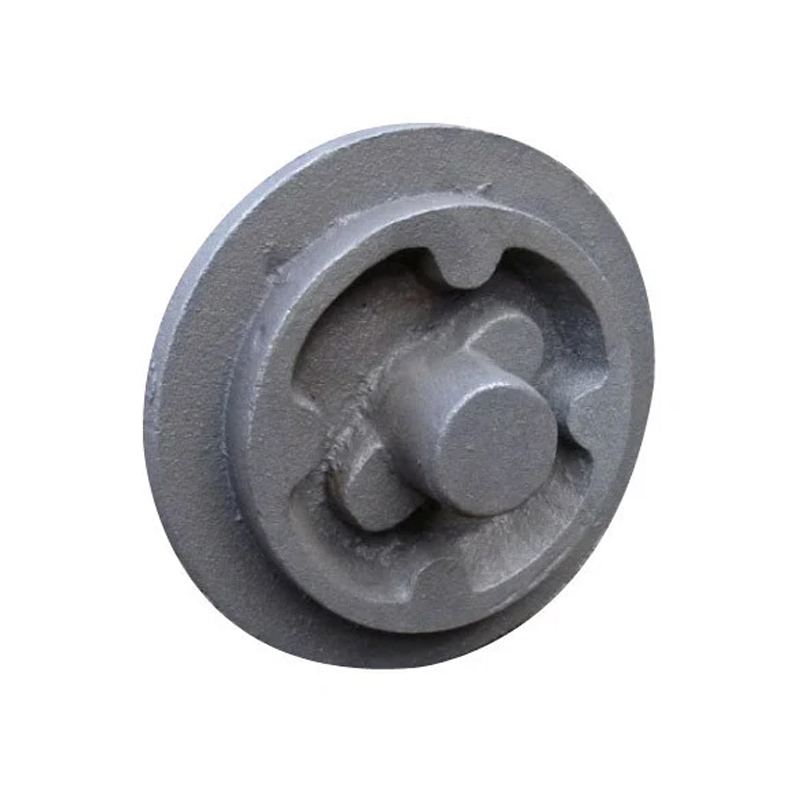
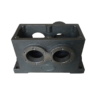
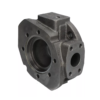
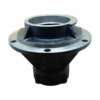
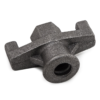

What machined iron casting jiangsu shengrong iron foundry can produce?
Gray Cast Iron/Chinese Standard (GB/T 9439):HT100, HT150, HT200, HT250, HT300, HT350
International Standard (ISO 185): G150, G250, G350
American Standard (ASTM A48): Class 20, Class 30, Class 40
Ductile Cast Iron/Nodular Cast Iron
Chinese Standard (GB/T 1348):QT400-18, QT450-10, QT500-7, QT600-3, QT700-2, QT800-2
International Standard (ISO 1083):EN-GJS-400-15, EN-GJS-600-3, etc.
American Standard (ASTM A536):60-40-18, 80-55-06, etc.
Advantages of Shengrong machined iron casting
1. High strength and wear resistance
By optimizing the composition (such as reasonable control of carbon and silicon content) and heat treatment process (such as annealing and normalizing), the tensile strength and hardness are improved.
2. Excellent casting performance
Good fluidity, can fill complex molds, and form thin walls or fine structures (such as engine cylinders, hydraulic valve bodies).
Low shrinkage (about 1% for gray cast iron), reducing shrinkage holes and crack defects.
3. High dimensional accuracy and surface quality
When precision casting (such as lost foam, resin sand) is used, the tolerance can reach CT6-8 level (ISO standard), and the surface roughness Ra≤6.3μm. Reduce the subsequent machining cost and is suitable for mass production.
4. Good shock absorption and cutting performance
Graphite structure (especially flake graphite) can absorb vibration, and the damping coefficient is 6-10 times that of steel, which is suitable for machine tool bases. Moderate hardness (HB170-240), small tool wear, and high processing efficiency.
5. Corrosion and heat resistance
Adding elements such as Cr, Ni, and Cu (such as high silicon cast iron containing 14-18% Si) can resist acid, alkali or high temperature oxidation (working temperature can reach 800℃).
6. Uniform and dense internal structure
Metallographic examination shows that the graphite morphology meets the standard (such as spheroidization rate ≥90%), the matrix has no grain boundary carbides, and the porosity is <1%.
7. Economy and reliability
The cost is 20-30% lower than that of cast steel, and non-destructive testing (ultrasound, X-ray) is used to ensure that there are no internal defects, and the service life is extended by more than 30%.
Applications of machined iron casting
Machine tool bed/guide rail: Gray cast iron (HT250, HT300) is often used for large machine tool basic structural parts with good shock absorption, wear resistance and high rigidity to reduce processing vibration.
Gear/Cam: Ductile iron (QT600-3, QT700-2) can replace some forged steel parts after heat treatment, which is lower cost and fatigue resistant.
Hydraulic parts: such as hydraulic valve body and pump housing, use compacted vermicular cast iron
Engine parts: Cylinder block and cylinder head are mostly made of high-strength gray cast iron (HT250) or alloy cast iron (containing Cr, Cu), which has excellent thermal fatigue resistance.
Braking system: Brake disc/drum often uses pearlite gray cast iron, which has good heat dissipation and stable friction coefficient.
Chassis parts: Ductile iron (QT400-18) is used for steering knuckles and control arms, which has both toughness and strength.
Pipeline system: Ductile iron pipes (DN80-DN2600) replace traditional gray iron pipes, with high pressure resistance, earthquake resistance, and a service life of more than 50 years.
Manhole covers/rainwater grates: QT500-7 castings are rust-proof and have a load-bearing grade of EN124 D400.
Wind power components: Large ductile iron hubs (QT350-22L) require low-temperature impact toughness of ≥12J at -20°C.
Internal combustion engine crankshaft: QT800-2 has a tensile strength of 800MPa after isothermal quenching, comparable to forged steel.
Corrosion-resistant parts: High silicon cast iron (containing 14.5% Si) is used for chemical pumps and valves, and is resistant to acid and alkali corrosion.
High-temperature parts: Medium silicon-molybdenum cast iron (Si4%-Mo1%) is used for boiler burners and is resistant to oxidation at 750°C.
Technical Capability
Advantages of Shengrong machined iron casting
1. High strength and wear resistance
By optimizing the composition (such as reasonable control of carbon and silicon content) and heat treatment process (such as annealing and normalizing), the tensile strength and hardness are improved.
2. Excellent casting performance
Good fluidity, can fill complex molds, and form thin walls or fine structures (such as engine cylinders, hydraulic valve bodies).
Low shrinkage (about 1% for gray cast iron), reducing shrinkage holes and crack defects.
3. High dimensional accuracy and surface quality
When precision casting (such as lost foam, resin sand) is used, the tolerance can reach CT6-8 level (ISO standard), and the surface roughness Ra≤6.3μm. Reduce the subsequent machining cost and is suitable for mass production.
4. Good shock absorption and cutting performance
Graphite structure (especially flake graphite) can absorb vibration, and the damping coefficient is 6-10 times that of steel, which is suitable for machine tool bases. Moderate hardness (HB170-240), small tool wear, and high processing efficiency.
5. Corrosion and heat resistance
Adding elements such as Cr, Ni, and Cu (such as high silicon cast iron containing 14-18% Si) can resist acid, alkali or high temperature oxidation (working temperature can reach 800℃).
6. Uniform and dense internal structure
Metallographic examination shows that the graphite morphology meets the standard (such as spheroidization rate ≥90%), the matrix has no grain boundary carbides, and the porosity is <1%.
7. Economy and reliability
The cost is 20-30% lower than that of cast steel, and non-destructive testing (ultrasound, X-ray) is used to ensure that there are no internal defects, and the service life is extended by more than 30%.
Applications of machined iron casting
Machine tool bed/guide rail: Gray cast iron (HT250, HT300) is often used for large machine tool basic structural parts with good shock absorption, wear resistance and high rigidity to reduce processing vibration.
Gear/Cam: Ductile iron (QT600-3, QT700-2) can replace some forged steel parts after heat treatment, which is lower cost and fatigue resistant.
Hydraulic parts: such as hydraulic valve body and pump housing, use compacted vermicular cast iron
Engine parts: Cylinder block and cylinder head are mostly made of high-strength gray cast iron (HT250) or alloy cast iron (containing Cr, Cu), which has excellent thermal fatigue resistance.
Braking system: Brake disc/drum often uses pearlite gray cast iron, which has good heat dissipation and stable friction coefficient.
Chassis parts: Ductile iron (QT400-18) is used for steering knuckles and control arms, which has both toughness and strength.
Pipeline system: Ductile iron pipes (DN80-DN2600) replace traditional gray iron pipes, with high pressure resistance, earthquake resistance, and a service life of more than 50 years.
Manhole covers/rainwater grates: QT500-7 castings are rust-proof and have a load-bearing grade of EN124 D400.
Wind power components: Large ductile iron hubs (QT350-22L) require low-temperature impact toughness of ≥12J at -20°C.
Internal combustion engine crankshaft: QT800-2 has a tensile strength of 800MPa after isothermal quenching, comparable to forged steel.
Corrosion-resistant parts: High silicon cast iron (containing 14.5% Si) is used for chemical pumps and valves, and is resistant to acid and alkali corrosion.
High-temperature parts: Medium silicon-molybdenum cast iron (Si4%-Mo1%) is used for boiler burners and is resistant to oxidation at 750°C.
Technical Capability

The production process of Shengrong valve casting mainly includes the following steps:
1. Process design and mold preparation
3D modeling and simulation: Design a 3D model based on the valve body structure, use casting simulation software (such as MAGMA, ProCAST) to simulate the filling and solidification process, and optimize the gating system and riser design.
Mold manufacturing: Use metal molds (such as cast iron molds or steel molds) or coated sand molds. Complex structures may use 3D printed sand molds (such as SLS technology).
2. Material selection and smelting
Material requirements: HT250, HT300 gray cast iron, or ductile iron (QT450-10)
Smelting control:
Electric furnace or cupola smelting, strictly control carbon equivalent (CE), sulfur and phosphorus content.
Ductile iron needs to be spheroidized (magnesium or rare earth alloy) and inoculated.
Smelting temperature: cast iron is usually 1500-1550℃
3. Molding and core making
Sand casting (mainstream process):
Resin sand molding (furan resin or phenolic resin): high precision, suitable for small and medium batches.
Coated sand shell mold: high surface finish, suitable for complex thin-walled valve bodies.
Core making: hot core box or cold core box process is used to make inner cavity sand core, and the core sand needs to have high disintegration (to avoid cleaning difficulties).
4. Pouring and solidification
Poting system design:
Open pouring system (such as bottom pouring) reduces turbulence and avoids slag inclusion and air holes.
Set up risers and chillers to ensure sequential solidification and avoid shrinkage cavities and shrinkage.
Pouring parameters:
Cast iron pouring temperature: 1350-1400℃ (adjusted according to wall thickness).
Pouring speed needs to be stable to avoid gas entrapment.
5. Cooling and sand dropping
Controlled cooling: The casting is slowly cooled in the sand mold (especially the thick wall part) to reduce residual stress.
Vibration sand dropping: The casting and the sand mold are separated by vibration equipment to avoid mechanical damage.
6. Cleaning and post-processing
Remove the pouring riser: use grinding wheel cutting or hydraulic punching machine.
Shot blasting/shot blasting cleaning: remove surface sand and oxide scale.
Heat treatment:
Gray cast iron: stress relief annealing (500-550℃ insulation and slow cooling).
Ductile iron: normalizing or quenching + tempering to improve strength.
Machining reference surface: provide positioning reference for subsequent CNC processing.
7. Quality inspection
Dimension inspection: three-coordinate measurement (CMM) key hole distance and flatness.
Nondestructive testing:
X-ray or ultrasonic flaw detection (internal defects).
Penetrant testing (surface cracks).
Pressure test: perform air pressure or hydraulic sealing test on the valve body flow channel.
8. Surface treatment and rust prevention
Phosphating or blackening treatment: improve corrosion resistance.
Anti-rust oil application: anti-rust oil packaging and delivery.
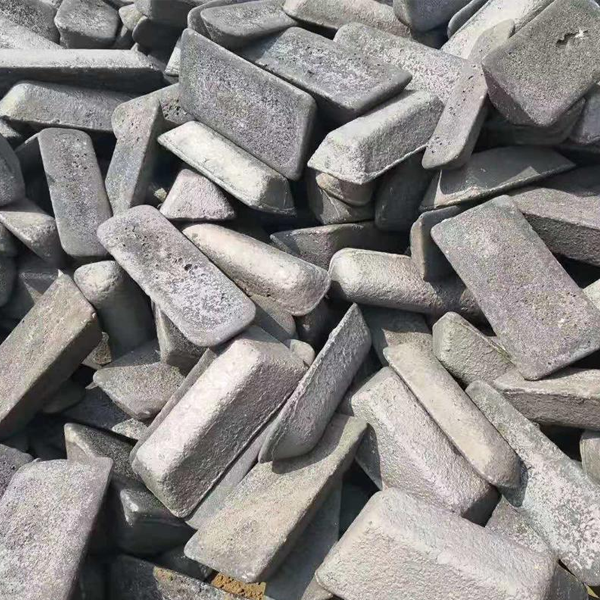
Raw material control
Use a spectrometer to monitor the melting composition (C, Si, Mn, P, S, etc.) in real time to ensure compliance with standards (such as HT250: C 3.0-3.3%, Si 1.8-2.2%).
Ductile iron needs to control the residual Mg (0.03-0.06%) and rare earth elements.Deoxidation: Add aluminum or silicon-calcium alloy to reduce pores.
Spheroidizing: Ductile iron uses the punching method or wire feeding method (spheroidizing rate ≥ 90%).Mold accuracy: 3D simulation optimization of the pouring and riser system (ProCAST/Magma software), the parting surface misalignment is ≤ 0.2mm.Resin sand: tensile strength ≥ 1.2MPa, moisture ≤ 4%.
Lost foam: EPS beads pre-expanded density 0.018-0.022g/cm³.Temperature control:Gray cast iron 1300-1400Ductile cast iron 1350-1420 15-25Pouring flow rate control 0.5-1.0kg/s.Porosity: Moulding sand air permeability ≥80, vacuum before pouring (lost foam).Shrinkage: Add chilled iron to thick wall, riser volume ≥30% of shrinkage compensation area.

Melting process control
Gray cast iron: furnace temperature 1450~1500℃, pouring temperature 1300~1350℃.
Ductile iron: furnace temperature 1500~1550℃ (promote spheroidization reaction).
Carbon equivalent (CE): adjusted according to the wall thickness of the casting (gray cast iron CE=3.9~4.3%), thick-walled parts take the lower limit to prevent coarse graphite.
Sulfur and phosphorus control: Ductile iron requires sulfur ≤0.02% (too high affects the spheroidization rate).
Pre-furnace detection: spectral analysis quickly detects the composition, and thermal analyzer predicts the graphite morphology
Inoculation treatment (gray cast iron/ductile iron):
Nodularizer (such as Mg5~8% rare earth alloy) added in an amount of 1.0~1.5%
Residual Mg is controlled at 0.03~0.06%, and residual RE ≤0.02% (too high is prone to slag inclusions).
Casting system design:
Avoid turbulence (such as bottom pouring) and reduce oxidation slag inclusions.
Casting time: slow pouring for thick-walled parts and fast pouring for thin-walled parts (to prevent cold insulation).
Cooling rate: the moisture content of the molding sand is ≤5% (wet molding sand), and the proportion of curing agent in resin sand needs to be controlled.

Turning: external circle and end face processing, pay attention to chip breaking (chip control should be considered for ductile iron).
Milling: use spiral edge milling cutter to reduce cutting force.
Drilling: use carbide drill to avoid built-up edge (appropriately increase the speed).
Grinding: for high hardness cast iron (such as white cast iron), it is necessary to select a suitable grinding wheel (such as CBN grinding wheel).

Spectroscopic analysis (OES, XRF): Rapid determination of the content of major elements such as C, Si, Mn, P, S, etc., suitable for rapid detection in front of the furnace.
Carbon-sulfur analyzer: Accurate determination of the content of carbon and sulfur.
Tensile strength: Determined by tensile test (such as gray cast iron HT250 indicates tensile strength ≥250 MPa).
Hardness test: Evaluate toughness and plastic deformation capacity.
Metallographic structure inspection: Observe the graphite morphology, matrix structure and defects under a microscope to judge the quality of cast iron. Graphite morphology:
Gray cast iron: flake graphite (A-type distribution is preferred).
Ductile iron: spheroidal graphite (spheroidization rate ≥80% qualified).
Nondestructive testing (NDT)
Detect internal defects (pores, shrinkage, cracks, etc.) and surface defects:
Magnetic particle testing (MT): Used for surface or near-surface crack detection (only applicable to ferromagnetic materials).
Dimension and geometric tolerance inspection: three-dimensional coordinate measuring machine (CMM)
Caliper, micrometer, profilometer:
Special inspection of casting defects
Shrinkage and porosity, slag inclusions and sand holes, metallographic observation or fracture analysis, cold shut and insufficient pouring:
Visual or penetrant inspection.
1: Advanced technology and equipment standards
Advanced technology: Sand casting, precision casting, and lost foam casting process. Casting sizes according to customer requirements, weights ranging from 0.5kg to 10,000kg
Automation equipment: Equipped with automated production lines, intelligent melting furnaces (medium frequency/high frequency induction furnaces),
Inspection equipment: Chemical composition/spectrometer and mechanical property inspection equipment, three-coordinate measuring machine (CMM), X-ray flaw detector, spectrometer, ultrasonic testing and other high-end quality inspection methods.
2:Quality management system
ISO 9001 (quality management system)
IATF 16949 (automotive industry quality management system, such as automotive parts)
ASTM/EN/JIS and other international material standards.
3:Customization capability
Customized production according to customer drawings, customers only need to pay half of the mold fee to develop new castings. The mold time is short, only 20 days, and the casting time only 10 days. Machining 10 days.
Free express sample to customers, mass production after customer samples are confirmed to be fully qualified. Our company does not require customers to place a minimum order quantity, satisfying customers with a variety of choices
4:Competitive prices
Our company’s prices are very competitive in the industry, and the specific price depends on the casting drawing and the customer’s order quantity. Welcome to inquire








Carbon, silicon, manganese, sulfur, phosphorus, chromium, nickel, copper and other elements

Tensile strength, yield strength, elongation, hardness, impact strength

Three-coordinate inspection, non-destructive testing, pressure testing, etc.

Every parts we will use anti-rust oil packing or primer, keep every parts in good condition after long time shipping.For small parts, we use wood box pallet packing.For bigger parts with pallet packing

Jiangsu Shengrong High end Equipment Manufacturing Industry Co., Ltd is a professional iron casting foundry about 26,000 square meters, Investment of 80 million yuan,include intermediate frequency furnace, new east Seoul horizontal line, cast star horizontal line, micro crystal automatic casting machine, 40T mixer and 20T mixer, core-making machine, shot blasting machine, machining center, inclined rail lathe, slot machine, vertical lathe, flat rail lathe and other equipment.Testing equipment:spectrometer, tensile testing machine, hardness tester, etc., and supporting chemical testing laboratories. Mainly engaged in: mechanical parts, auto parts, industrial pump parts, bearings and transmission parts manufacturing. Company’s main business: QT450-12, 500-7, 600-3 ball mill castings and HT250, HT300 gray iron castings and cast steel, stainless steel and other business, with the increase of business volume, the production is not only to meet the main business, while the product after the process of product processing business development, so that enterprises diversified production. Now the company has more than 100 employees, including a professional management team and new product development.
CONTACT
Get In Touch